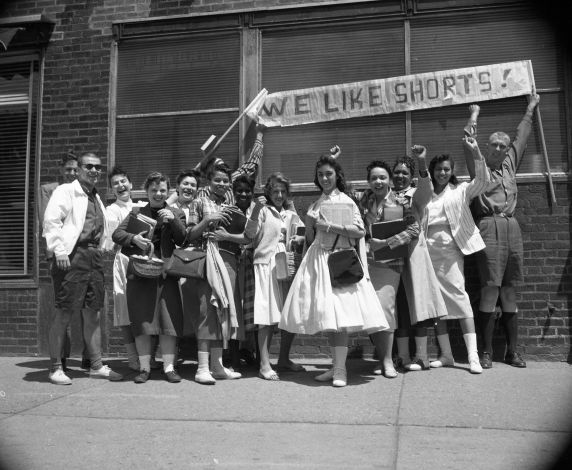Guest Post: Laura Kennedy on Raven Award Experience
It was truly an honor to receive the Fall 2017 Raven Award and an invaluable experience to work closely with the audiovisual archivists at the Reuther Library. I am in my second year as a graduate student at Wayne State and I am pursuing a dual master’s: an MLIS from the School of Information Sciences (with an archives concentration) and an MA in History through the history department. Having the opportunity to work on a project at the Reuther fit in nicely with my personal interests and academic goals.
The project I worked on over the semester originally consisted of processing a box of negatives taken by the photographers of Wayne State’s student newspaper, The Daily Collegian, (predecessor of The South End). The negatives spanned about a decade (1950-1960, but the bulk of the collection covered 1958-1960. The box appeared to have been packed hastily and there was no obvious organization scheme, so the first step in processing was to arrange the negatives by date, since chronology would most closely follow the production of the paper. Most of the negatives were in sleeves and some of the sleeves had detailed information, including the date and subject of the negative. Other sleeves had no information or information that was impossible to read.
Once the negatives were arranged by date, the next step was to rehouse them into archival envelopes. For the negatives that had information written on the original envelopes, that information was transferred to the new envelopes and then these were placed into archival boxes in chronological order. There were also quite a few negatives that had no envelopes or were undated, and those had to be organized by subject matter using the Library of Congress subject headings. These negatives were then put into alphabetical order by subject and put into the boxes. I was able to use the Reuther’s bound copies of the newspaper to cross reference some of the negatives, and this filled in or clarified some of the information.
Then, the information from the new envelopes needed to be inventoried. This consisted of copying the subject and date from each envelope into a spreadsheet and then adding the box and folder number to the envelope. The size of the negative was also entered at this point. The majority of the negatives were 4x5, but there were several 120 mm and some 35 mm negatives. The collection also contains some slides and those were housed in slide pages and also entered into the spreadsheet. All of this information would be used as part of the finding aid.
Starting work on the finding aid was the next step of the process. This was achieved through ArchivesSpace, the open source software program the Reuther uses for managing their collections. This step consisted of entering basic information about the collection, as well as researching the history of the student newspaper using resources held by the Reuther. This was a really exciting part of the process and uncovered some interesting facts about the history of the student newspaper. The information was entered in the history, scope and content, and abstract notes in ArchivesSpace and would be used as part of the finding aid.
A box of prints was also included in the collection and needed to be organized and documented. These prints were from approximately the 1970s through the early 1990s. These prints became Series 2 of the collection. Because the prints were not dated, they were also organized by subject matter using the Library of Congress subject headings. The prints were rehoused in new folders and put into a manuscript box. The information was then added to the inventory spreadsheet.
Once everything had been described, a list of negatives with interesting subjects was prepared and given to one of the audiovisual archivists who narrowed down the list to a manageable number. The selected images were then scanned, and another spreadsheet was created to reflect information unique to each scanned image. In total, 170 images were scanned and added to this metadata spreadsheet.
Overall, this project not only provided valuable hands-on experience working with an audiovisual collection, but also insight into how an archive like the Reuther functions as an institution. It also allowed me to glimpse a small piece of Wayne State’s past through the images captured during this specific time period. One of the highlights of the project was getting to meet Mr. Raven and his wife when they visited campus in October. It was exciting to get to tell them a little bit about the collection and the work I was doing, and to thank them personally for their generous support.
Laura Kennedy was the Fall 2017 recipient of the Ronald Raven Annual Award. This is her summary of the internship.


 Reddit
Reddit Facebook
Facebook LinkedIn
LinkedIn